In the crowded digital marketplace, a visually appealing online store is just the starting point. The best website design for ecommerce goes deeper, blending aesthetics with intuitive navigation, high-speed performance, and a frictionless checkout process that converts browsers into loyal customers. It's a strategic fusion of art and science, where design decisions directly impact your bottom line.
A great design not only showcases your products but also builds trust, tells your brand story, and creates a seamless user experience across all devices. Ensuring your website adapts flawlessly to any device is crucial for modern shoppers. Understanding the top responsive web design best practices for 2025 is a foundational step in this process, guaranteeing accessibility and a positive user experience for everyone.
This article dissects seven leading examples, from comprehensive design agencies to powerful DIY platforms, revealing the specific strategies that make them so effective. We will explore the replicable tactics behind their success, providing you with a clear roadmap to elevate your own online store. Inside, you'll find detailed analysis, screenshots, and direct links to see each design in action. Let's dive in and transform your digital storefront from a simple catalog into a powerful sales engine.
1. Sugar Pixels
Sugar Pixels distinguishes itself not just as a website builder, but as a full-service digital agency, offering an integrated approach that makes it a formidable contender for the best website design for ecommerce. It’s an ideal solution for businesses that prefer a hands-off, expert-led process from design and development to ongoing marketing and maintenance. This model allows entrepreneurs to focus on their core business operations while a dedicated team handles the technical complexities of building and scaling an online store.
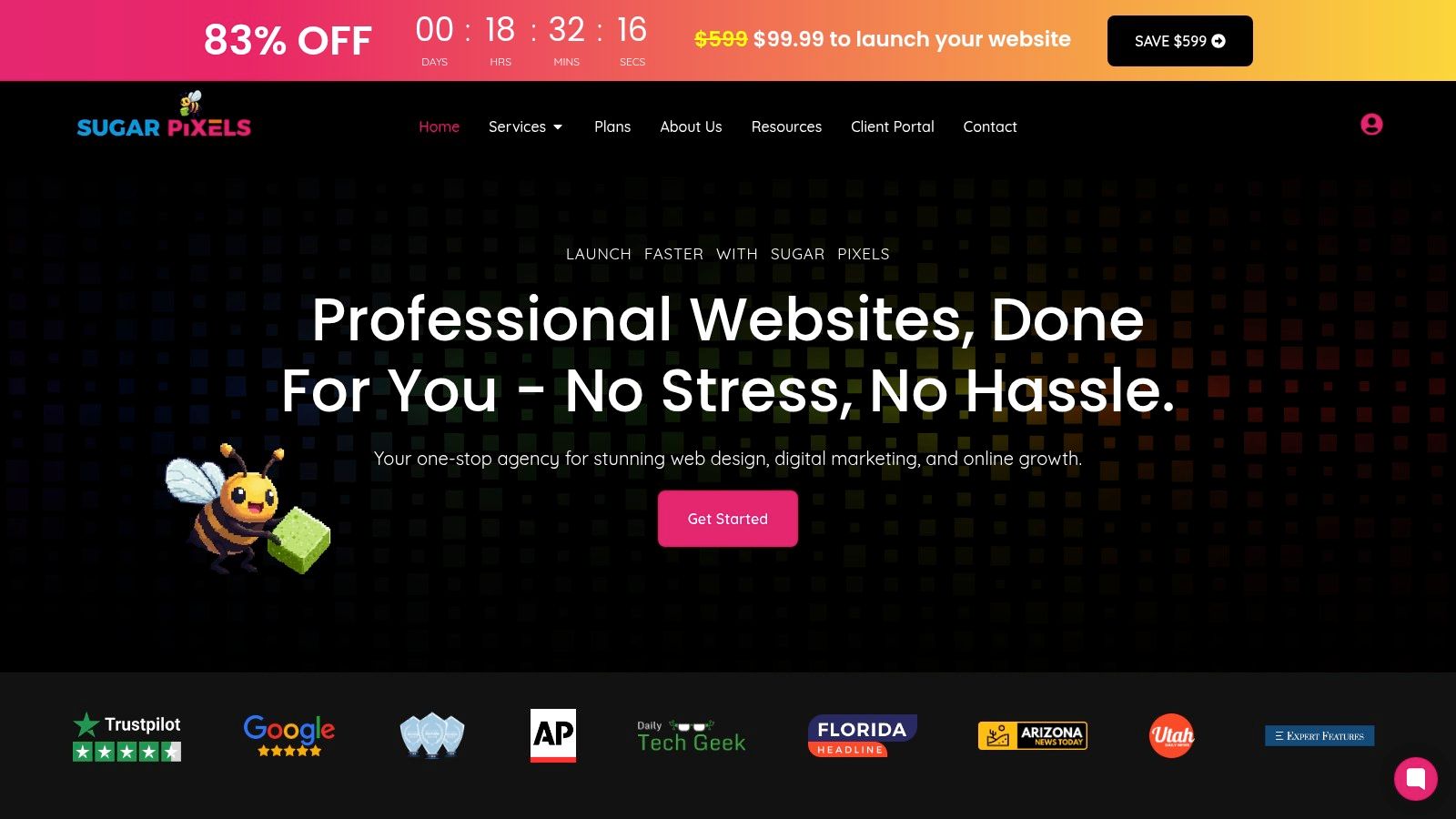
The platform’s core strength lies in its all-in-one service suite. Unlike DIY platforms where users are responsible for everything, Sugar Pixels provides custom design, secure hosting, SEO optimization, and robust ecommerce functionality as a unified package. This eliminates the need to juggle multiple vendors for hosting, design, and marketing, creating a streamlined and cohesive digital strategy from day one.
Strategic Analysis: The "Done-For-You" Advantage
The primary strategic advantage of Sugar Pixels is its "done-for-you" service model. This is particularly valuable for small to medium-sized businesses and startups that lack in-house technical or design expertise. By bundling essential services, they ensure that every aspect of the online presence is professionally managed and aligned.
- Integrated Ecommerce & Marketing: Sugar Pixels builds sites with marketing in mind. Their services include setting up affiliate programs and executing email marketing campaigns, ensuring the ecommerce store is not just a digital catalog but a powerful sales and lead generation engine.
- Scalability by Design: The tiered pricing structure is built for growth. A business can start with a simple one-page site or a basic ecommerce store and scale up to a multi-page, unlimited-product enterprise solution without needing to migrate platforms. This built-in scalability is a significant long-term benefit.
- Expertise on Demand: Clients gain access to a team with decades of combined experience. This is a crucial differentiator from DIY builders, where the quality of the final product is limited by the user's own skills.
Key Features & Benefits
| Feature | Practical Benefit for Ecommerce |
|---|---|
| All-in-One Service | Simplifies vendor management; ensures design, hosting, and marketing are cohesive. |
| Tiered Pricing Plans | Accessible for startups ($14.99/mo) and scalable for enterprises ($199.99+/mo). |
| Custom Design | Creates a unique brand identity that stands out from template-based competitors. |
| Managed Hosting & SEO | Ensures website performance, security, and visibility are handled by professionals. |
| Affiliate & Email Marketing | Provides built-in tools to drive traffic, nurture leads, and boost conversions. |
Actionable Takeaways
For businesses evaluating ecommerce solutions, Sugar Pixels is the premier choice for those who value expert guidance and integrated services over a hands-on, DIY approach. The initial setup fees ($49-$99) should be viewed as an investment in professional setup, which can save significant time and prevent costly mistakes down the line. To maximize value, businesses should leverage the full suite of services, especially the marketing components, to create a holistic growth strategy. While lower-tier plans have ticket-based support, the platform's reliability and professional management minimize the need for frequent technical help.
Website: https://www.sugarpixels.com
2. Shopify Theme Store
For merchants building on the Shopify platform, the official Theme Store is the gold standard for sourcing high-quality, performance-optimized designs. It serves as a curated marketplace of both free and premium themes, each rigorously vetted by Shopify to ensure compatibility, speed, and security. This vetting process is a key differentiator, offering a layer of quality assurance not always present in third-party marketplaces.
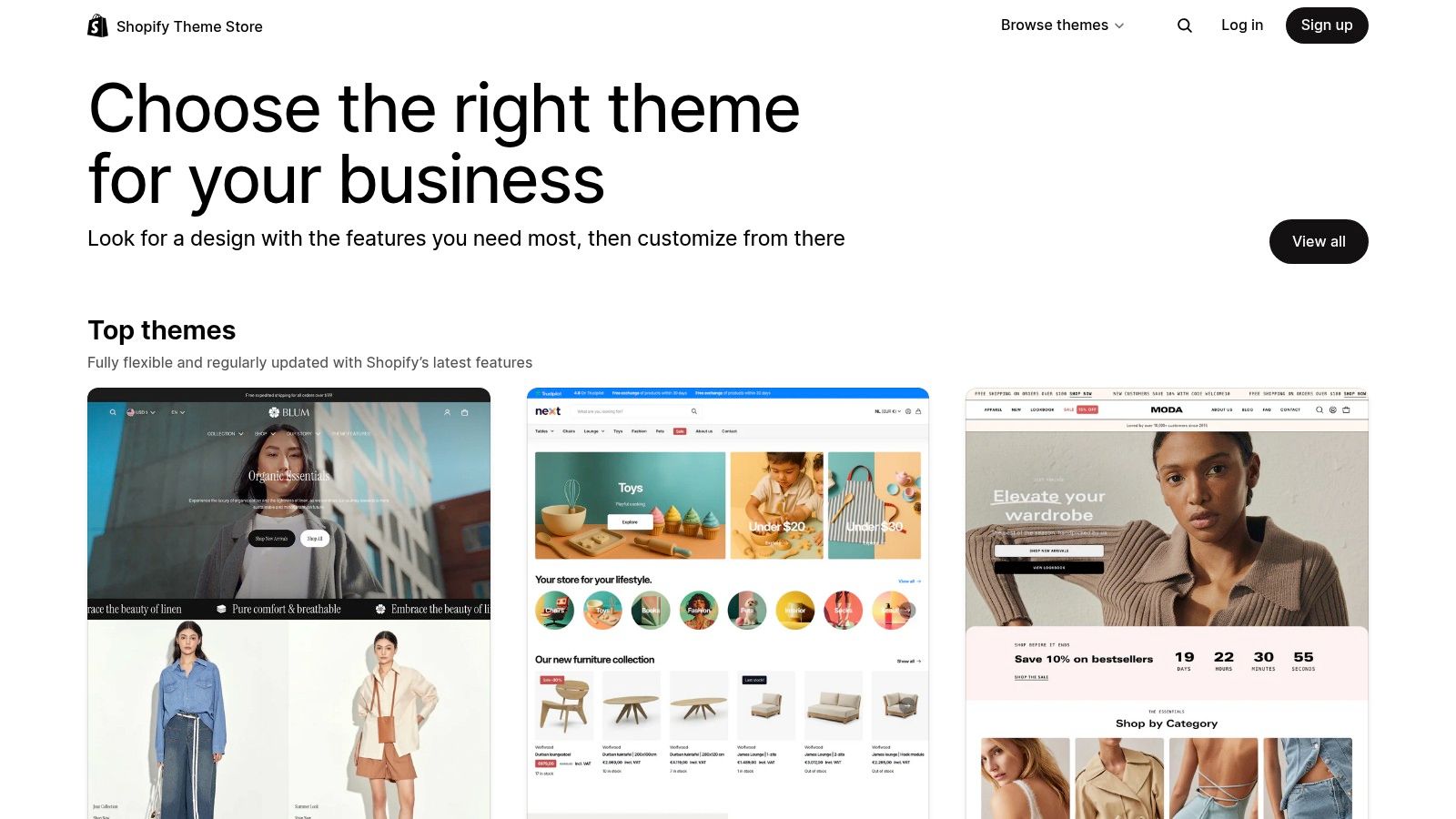
The platform excels in user experience, allowing entrepreneurs to browse themes by industry, catalog size, or specific features like "quick view" and "sticky header." Every theme includes a live demo, letting you interact with the design as a customer would before committing. This commerce-first approach ensures that every design element is built around a single goal: conversion.
Strategic Breakdown
The core advantage of using the Shopify Theme Store is its seamless integration. Themes are guaranteed to work flawlessly with Shopify’s native features, including its industry-leading checkout and a vast ecosystem of apps. This eliminates the technical headaches often associated with integrating third-party designs. While prices for premium themes can range from $180 to over $350, the investment includes ongoing developer support and free updates, ensuring your site remains modern and secure.
Key Takeaway: The Shopify Theme Store prioritizes a secure, integrated, and conversion-focused experience over offering the lowest price. This makes it one of the best sources for reliable ecommerce website design, especially for merchants who value stability and performance.
Pros and Cons
| Pros | Cons |
|---|---|
| Guaranteed Quality: All themes are vetted by Shopify for performance. | Higher Cost: Premium themes are pricier than average. |
| Seamless Integration: Works perfectly with Shopify's checkout and apps. | Platform Lock-In: Only works within the Shopify ecosystem. |
| Strong Support: Includes developer support and free theme updates. | Limited Customization: Less flexible than custom builds. |
Website: https://themes.shopify.com
For those just starting, understanding the platform is crucial. You can explore a detailed comparison to find the best ecommerce platform for beginners to see how Shopify stacks up against its competitors.
3. WooCommerce Marketplace (Themes + Extensions)
For entrepreneurs building on the flexible foundation of WordPress, the official WooCommerce Marketplace is the definitive source for powerful themes and extensions. It serves as the central hub for designs and tools specifically built for WooCommerce, offering a mix of free and premium options. Unlike all-in-one platforms, WooCommerce provides unparalleled control, and this marketplace is where users find the building blocks to create a truly custom ecommerce experience.
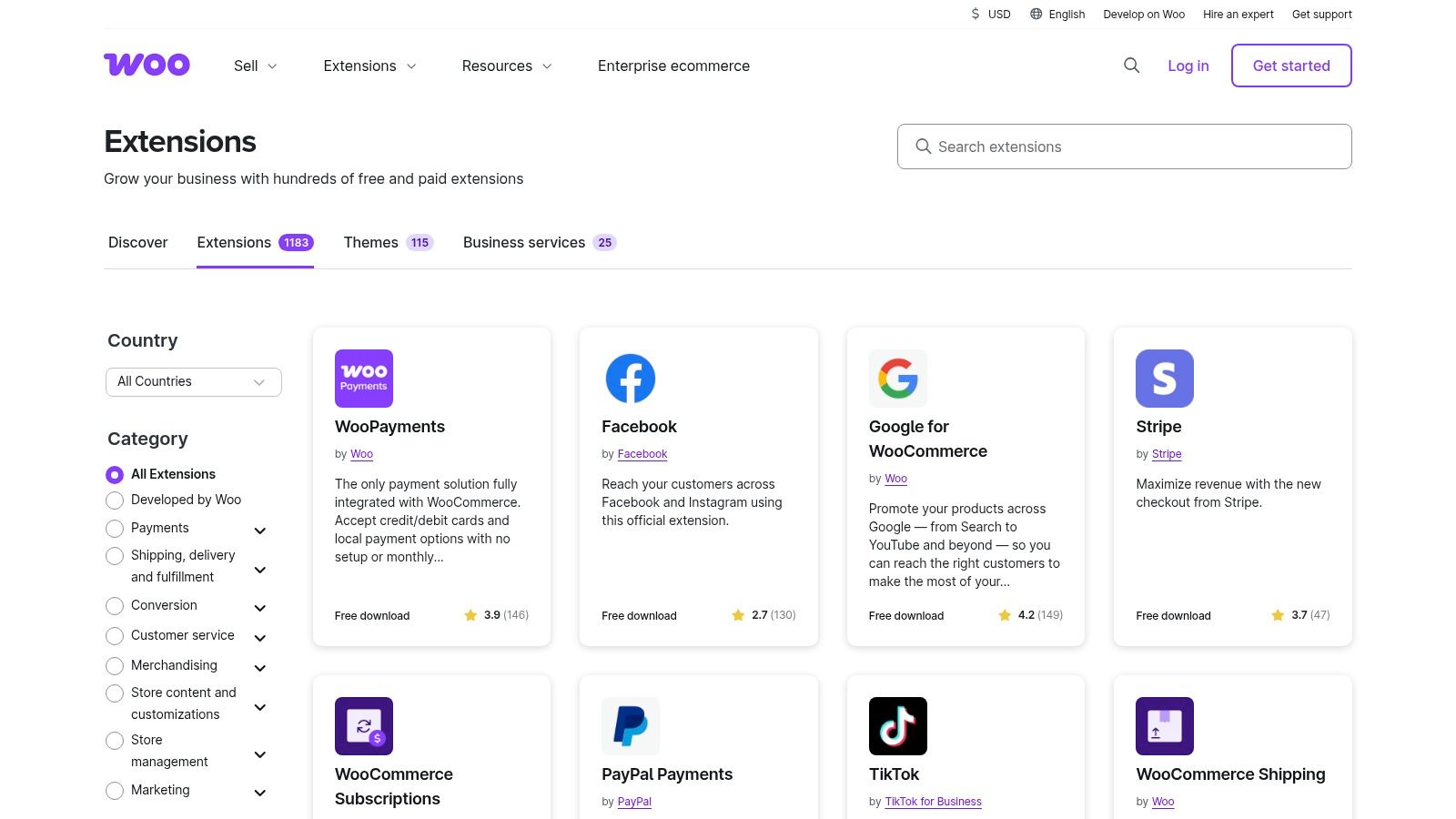
The marketplace is logically divided into themes for aesthetics and extensions for functionality, such as subscriptions, payments, and advanced shipping logic. Users can find designs tailored to their niche and even leverage modern block-based and Full Site Editing-ready themes for drag-and-drop customization. Every product page includes clear pricing, version history, and developer support details, and all purchases come with a 30-day money-back guarantee, providing a layer of security.
Strategic Breakdown
The core advantage of the WooCommerce Marketplace is its commitment to extensibility within the open-source WordPress ecosystem. You own your data and have complete control over hosting and customization. This makes it a prime choice for the best website design for ecommerce for businesses that anticipate unique needs or complex operational requirements down the line. While it requires more hands-on management than a hosted solution, the payoff is a store that can be scaled and modified without platform limitations.
Key Takeaway: The WooCommerce Marketplace empowers users with total ownership and infinite flexibility. It's the ideal resource for merchants who prioritize custom functionality and long-term scalability over the plug-and-play simplicity of closed-source platforms.
Pros and Cons
| Pros | Cons |
|---|---|
| Open & Extensible: Total control with the WordPress stack. | More Maintenance: Requires hands-on assembly and updates. |
| Broad Selection: Wide variety of niche-specific themes and extensions. | Quality Varies: Vendor quality and support can differ; vetting is key. |
| Official Support: Clear pricing with included support and updates. | Steeper Learning Curve: Less beginner-friendly than all-in-one builders. |
Website: https://woocommerce.com/marketplace
4. ThemeForest (Envato Market) – Ecommerce Themes Marketplace
For entrepreneurs seeking maximum variety and competitive pricing, ThemeForest is a vast marketplace offering thousands of ecommerce themes for platforms like WooCommerce, Shopify, Magento, and more. Unlike curated stores, ThemeForest operates as an open market where independent developers sell their designs. This model fosters immense diversity, providing options for nearly any niche, aesthetic, or functional requirement you can imagine.
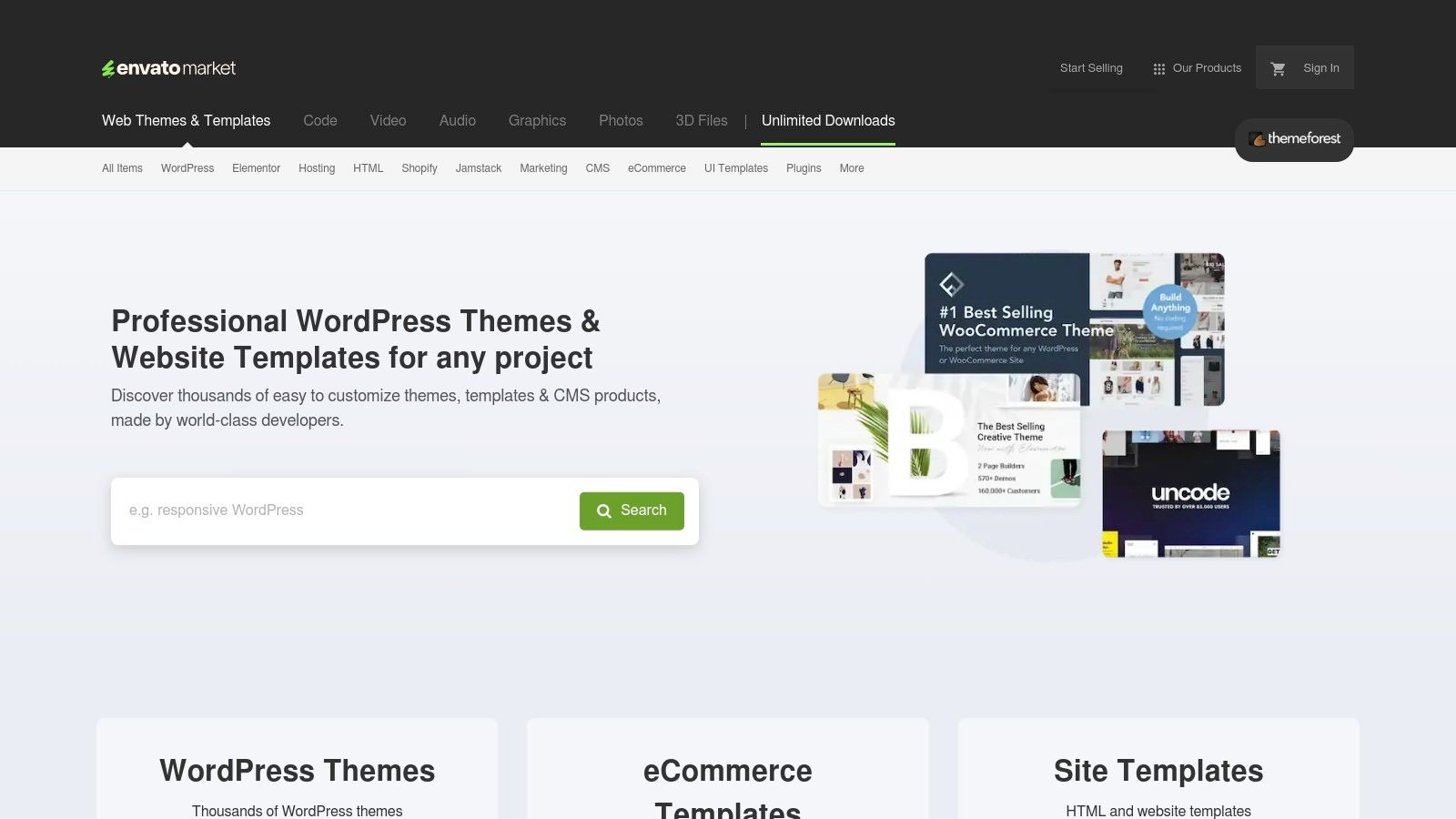
The platform empowers users with extensive filtering tools, allowing them to sort by platform, features, price, and popularity. Each theme listing includes a live demo, customer reviews, sales statistics, and a comments section for pre-purchase questions. This transparency helps merchants perform due diligence before committing, which is crucial in such a large, unvetted marketplace.
Strategic Breakdown
The primary advantage of ThemeForest is its cost-effectiveness and unparalleled selection, which makes it a fantastic source for finding the best website design for ecommerce on a budget. Premium WordPress themes often range from $39 to $69 and typically include six months of author support. However, this freedom comes with a trade-off: quality and support can vary significantly between authors. It is essential to check a theme's update history, sales figures, and author rating to mitigate risk.
Key Takeaway: ThemeForest excels in offering a massive, budget-friendly selection of ecommerce designs. Success on this platform requires careful vetting of individual authors and themes, making it ideal for merchants who are comfortable conducting their own quality assurance.
Pros and Cons
| Pros | Cons |
|---|---|
| Extensive Selection: Thousands of themes for various platforms and niches. | Variable Quality: No official vetting means quality and support differ widely. |
| Cost-Effective: Often more affordable than official theme stores. | Support Inconsistency: Support depends entirely on the individual theme author. |
| Transparent Metrics: User reviews and sales data help in decision-making. | Potential for Bloat: Some themes may be overloaded with unnecessary features. |
Website: https://themeforest.net
While templates offer a great starting point, some brands may require deeper modifications. To understand the possibilities beyond off-the-shelf designs, you can explore the benefits of custom e-commerce development to achieve a truly unique user experience.
5. Webflow Ecommerce
Webflow Ecommerce bridges the gap between template-based ecommerce builders and fully custom-coded sites. It is a visual web design platform that gives designers and entrepreneurs precise control over every pixel, enabling the creation of bespoke, interaction-rich online stores without writing a single line of code. This design-first approach empowers brands to build unique digital storefronts that stand out in a crowded market.
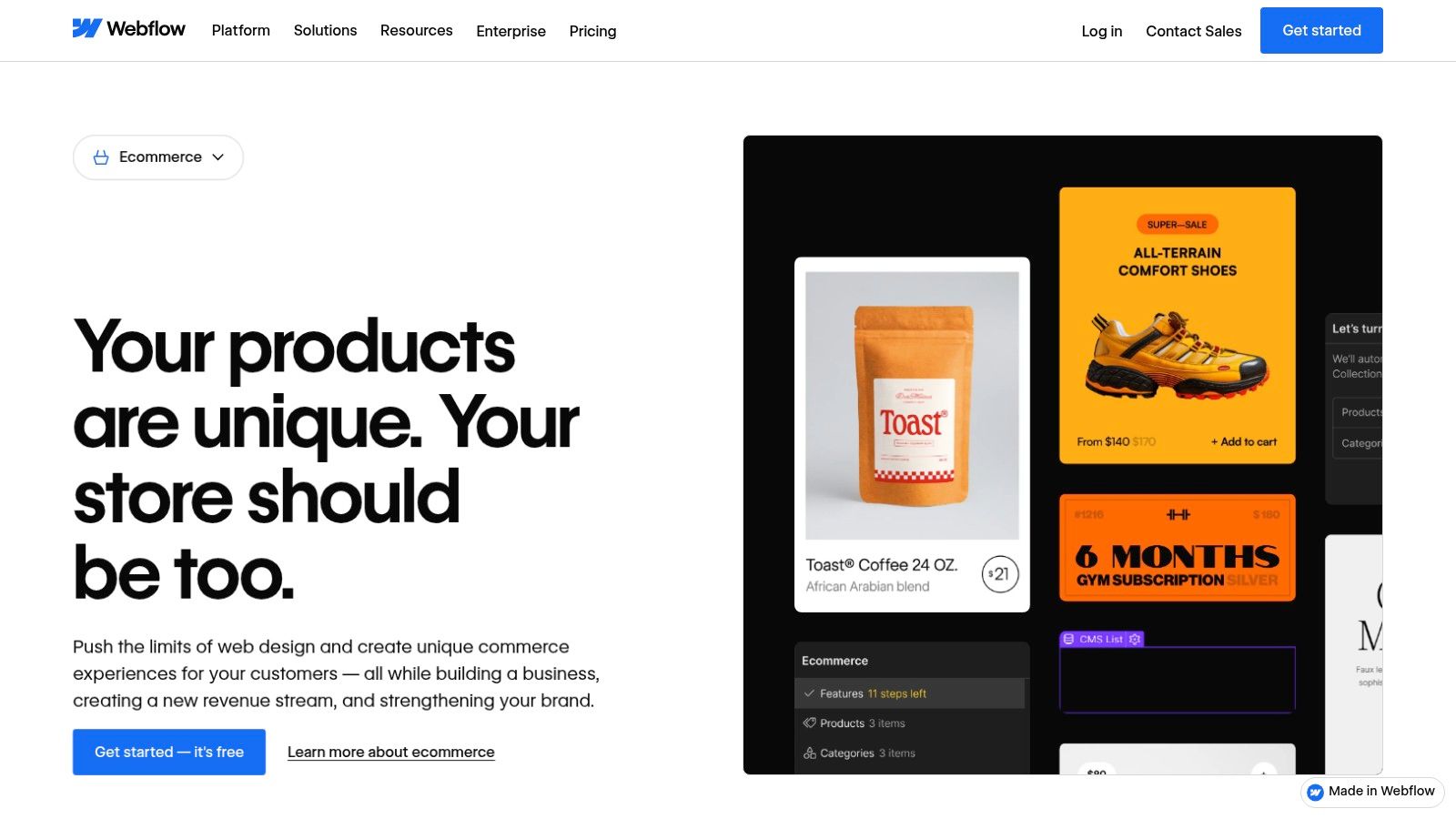
The platform is built around its powerful Visual Designer, which generates clean, semantic HTML, CSS, and JavaScript as you design. This tool is paired with a fully integrated Content Management System (CMS) for products and blog content, along with native ecommerce features like a customizable shopping cart, integrated checkout with Stripe and PayPal, and automatic tax calculations. This combination makes it a formidable option for those who prioritize a unique brand experience.
Strategic Breakdown
Webflow's core advantage is its unparalleled design freedom within a no-code framework. Unlike template-heavy platforms, it allows you to build completely custom layouts, interactions, and animations, making it one of the best choices for a truly unique ecommerce website design. Its fast, managed hosting with a global CDN ensures that these design-heavy sites still load quickly, protecting user experience and SEO rankings. While there is a steeper learning curve compared to simpler builders, Webflow's extensive educational resources (Webflow University) are highly regarded for getting users up to speed.
Key Takeaway: Webflow Ecommerce is the ideal platform for design-conscious brands that need full creative control without the overhead of custom development. It trades the plug-and-play simplicity of other builders for limitless design flexibility.
Pros and Cons
| Pros | Cons |
|---|---|
| Exceptional Design Flexibility: Unmatched control over layout and style. | Steeper Learning Curve: Requires time to master for non-designers. |
| High-Performance Hosting: Fast hosting with SSL is included in all plans. | CMS Limitations: Item limits on lower-tier plans can be restrictive. |
| Strong Learning Resources: Webflow University provides excellent tutorials. | Smaller App Ecosystem: Fewer third-party integrations than Shopify. |
Website: https://webflow.com/ecommerce
6. BigCommerce
BigCommerce is a powerful, hosted ecommerce platform designed for ambitious brands and high-volume merchants. It provides a robust framework for creating sophisticated online stores, combining a user-friendly theme marketplace with enterprise-level features. Its core strength lies in its scalability, offering tools that support businesses from their first sale to becoming a global, multi-channel operation.
The platform provides a curated theme marketplace with modern, responsive designs that can be filtered by industry and catalog size. Where BigCommerce truly differentiates itself is through its built-in features that cater to growth, such as native multi-storefront capabilities, comprehensive B2B functionalities, and powerful APIs for headless commerce. This focus on performance and flexibility makes it a top choice for serious retailers.
Strategic Breakdown
The key advantage of BigCommerce is its "all-in-one" nature without sacrificing performance. Unlike some platforms that require numerous third-party apps for core functions, BigCommerce includes powerful SEO tools, single-page checkout, and omnichannel integrations out of the box. This built-in functionality is crucial for maintaining site speed and security. Its pricing model, which has no additional BigCommerce transaction fees on any plan, offers transparent value as a business scales.
Key Takeaway: BigCommerce offers one of the best website design for ecommerce frameworks for scaling businesses, prioritizing built-in performance, strong SEO capabilities, and omnichannel readiness over the simplicity of entry-level builders.
Pros and Cons
| Pros | Cons |
|---|---|
| Strong Out-of-the-Box SEO: Excellent native SEO features and performance. | Higher Monthly Pricing: Plans start at a higher cost. |
| Scalability Focused: Ideal for growing brands and omnichannel catalogs. | Sales Caps: Annual sales limits can force plan upgrades. |
| No Platform Transaction Fees: Clear pricing without hidden costs. | Steeper Learning Curve: Can be more complex than basic builders. |
Website: https://www.bigcommerce.com
Its strong native performance features provide a solid foundation, which you can build upon by exploring an expert guide to online store SEO.
7. Squarespace Commerce (new 2025 plans)
Squarespace is an all-in-one website builder renowned for its elegant, design-forward templates and integrated commerce capabilities. It's a powerhouse for small to mid-size, brand-centric businesses, supporting physical products, subscriptions, and memberships. The platform's new 2025 plan lineup solidifies its position by offering commerce features across all tiers, including a built-in checkout, US tax automation, and marketing tools.
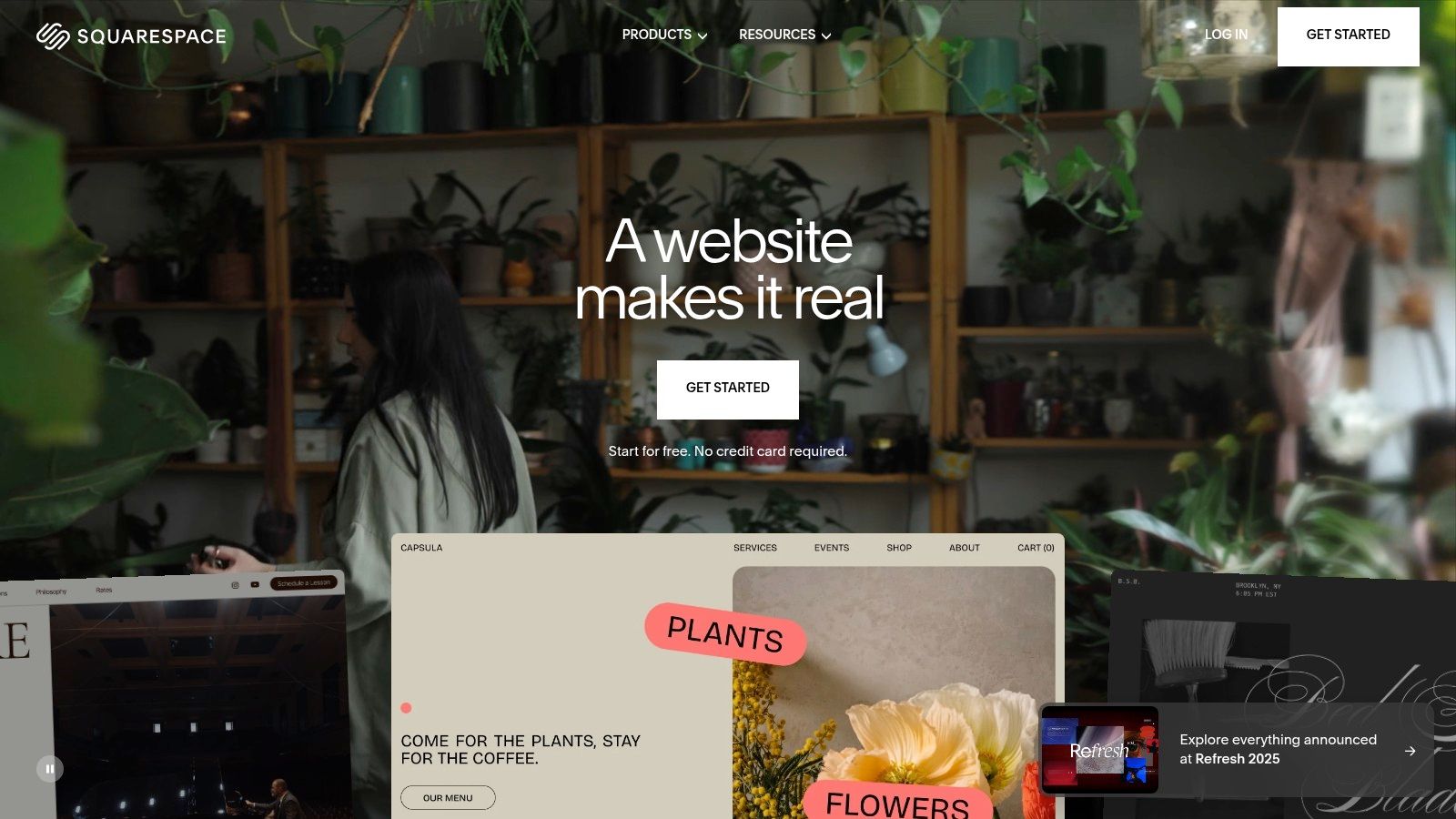
The platform stands out for its simplicity and aesthetic quality, allowing entrepreneurs to launch a professional-looking store quickly. Its Fluid Engine editor offers intuitive drag-and-drop functionality, giving users creative control over responsive layouts without needing to code. This focus on premium design makes it a top choice for brands where visual presentation is paramount to the customer experience.
Strategic Breakdown
The core strength of Squarespace lies in its unified ecosystem. It combines hosting, design, and commerce into a single, cohesive package, eliminating the complexity of managing separate services. This streamlined approach is perfect for merchants who want to focus on their brand and products rather than technical maintenance. With built-in tools like abandoned cart recovery and 24/7 customer support, Squarespace provides the essential infrastructure needed to grow a business from the ground up.
Key Takeaway: Squarespace Commerce offers one of the best website design for ecommerce experiences for brand-led businesses, prioritizing sophisticated aesthetics and an all-in-one, user-friendly platform over deep, open-source customizability.
Pros and Cons
| Pros | Cons |
|---|---|
| Fast to launch with refined design quality: Launch a beautiful, professional store quickly. | Less extensible than open-source stacks: Fewer integrations than competitors. |
| Simplified, all-in-one stack: Hosting, design, and commerce are fully integrated. | Advanced customization can be limited: Not as flexible as a custom build. |
| Ideal for brand-led stores: Perfect for small to mid-size product catalogs. | Mid-tier pricing: More expensive than basic budget site builders. |
Website: https://www.squarespace.com
Top 7 Ecommerce Website Design Platforms Comparison
| Platform | Implementation Complexity 🔄 | Resource Requirements ⚡ | Expected Outcomes 📊 | Ideal Use Cases 💡 | Key Advantages ⭐ |
|---|---|---|---|---|---|
| Sugar Pixels | Medium – Agency-led setup with fees | Moderate – Setup fees plus monthly plans | High – Custom designs with full digital marketing integration | Businesses seeking full-service web & marketing solutions | All-in-one agency, flexible pricing, VIP support |
| Shopify Theme Store | Low – Instant theme purchase & setup | Low – No coding needed, hosted ecosystem | Medium-High – Reliable, commerce-optimized themes | Merchants needing easy, reliable Shopify integration | Commerce-first vetted themes, easy setup, strong support |
| WooCommerce Marketplace (Themes + Extensions) | Medium-High – Requires assembly, maintenance | Medium – Diverse themes & extensions to manage | Medium – Flexible, self-hosted ecommerce sites | WordPress users wanting full control and extensibility | Open stack, niche themes, official support |
| ThemeForest (Envato Market) | Medium – Self-managed theme integration | Low-Medium – Theme purchase only | Variable – Depends on theme quality and author support | Users needing diverse styles and cost-effective options | Extensive selection, broad niches, user reviews |
| Webflow Ecommerce | High – Visual custom design with CMS | Medium – Requires design skills and CMS management | High – Bespoke, design-driven ecommerce sites | Teams prioritizing custom, code-free design | Exceptional design flexibility, fast hosting, strong resources |
| BigCommerce | Medium – Hosted platform, multi-store scaling | Medium-High – Subscription + scaling costs | High – Scalable, B2B-capable ecommerce | Growing or high-volume stores needing multi-channel support | No transaction fees, strong SEO, omnichannel support |
| Squarespace Commerce (2025 plans) | Low-Medium – Intuitive builder with preset plans | Low – All-in-one hosting and commerce | Medium – Elegant, brand-focused online stores | Small to mid-size brand-led US businesses | Fast launch, design quality, integrated marketing & support |
Choosing the Right Design Partner for Your Ecommerce Vision
Throughout this guide, we've explored a powerful spectrum of tools and platforms, each offering a unique pathway to achieving the best website design for ecommerce. We've analyzed everything from the vast, ready-to-use templates in the Shopify Theme Store and ThemeForest to the flexible, code-optional environments of Webflow and Squarespace. The journey has shown that there is no single "best" solution, only the one that aligns perfectly with your specific business needs.
The common thread connecting all successful ecommerce designs is a strategic foundation. It’s not just about aesthetics; it’s about creating an intuitive, high-performing digital storefront that converts visitors into loyal customers. The examples we reviewed prove that a winning design is a blend of brand identity, user experience (UX), and technical excellence.
Synthesizing Your Strategy
As you move forward, the key is to translate these insights into a tangible plan. The right choice hinges on a clear-eyed assessment of your resources, timeline, and long-term goals.
- For Speed and Simplicity: Marketplaces like the Shopify Theme Store or WooCommerce Marketplace offer a direct route to launching a professional-looking store. These are ideal for startups and small businesses that need to get to market quickly with a proven, reliable foundation.
- For Customization and Control: Platforms such as Webflow and BigCommerce provide the granular control needed to build a truly bespoke user experience. They are suited for growing businesses and enterprises that require unique functionality and want to stand out from the competition.
- For a Comprehensive, Hands-Off Approach: If your focus is on running your business rather than managing web development, a full-service partner like Sugar Pixels is invaluable. This path is for brands seeking an expert-led, all-in-one solution that integrates design, development, and ongoing strategy.
Key Factors for Implementation
Regardless of the tool you choose, successful implementation demands attention to detail. Technical execution is where a great design concept becomes a functional, fast-loading reality. For instance, developers often work with different measurement units to ensure a design is fully responsive across all screen sizes. Ensuring consistency between a design file (often in pixels) and the final code (often in REMs or EMs) is critical, and many use a specialized this REM converter tool to streamline this process and maintain design integrity.
Ultimately, the best website design for ecommerce is a living entity. It requires ongoing optimization, A/B testing, and adaptation to user feedback. The platform or partner you select should not only help you launch but also empower you to grow and evolve. By carefully aligning your vision with the right tools and expertise, you can build a powerful, profitable online presence that captivates your audience and drives sustainable success.
Ready to transform your vision into a high-performing ecommerce reality without the guesswork? The expert team at Sugar Pixels specializes in creating custom, conversion-focused websites that blend stunning design with powerful marketing strategy. Schedule your free consultation today and let's build an online store that drives results.